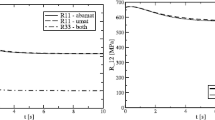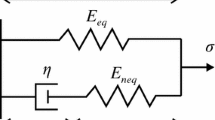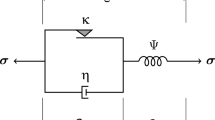Abstract
Apart from time-driven creep or relaxation, most viscoplastic models (without plastic and viscous strain separation) generate no or a very limited accumulation of strain or stress due to cyclic loading. Such pseudo-relaxation (or pseudo-creep) is either absent or dwindles too fast with increasing OCR. For example, the accumulation of the pore water pressure and eventual liquefaction due to cyclic loading cannot be adequately reproduced. The proposed combination of a viscous model and a hypoplastic model can circumvent this problem. The novel visco-hypoplasticity model presented in the paper is based on an anisotropic preconsolidation surface. It can distinguish between the undrained strength upon triaxial vertical loading and horizontal loading. The strain-induced anisotropy is described using a second-order structure tensor. The implicit time integration with the consistent Jacobian matrix is presented. For the tensorial manipulation including numerous Fréchet derivatives, a special package has been developed within the algebra program MATHEMATICA (registered trade mark of Wolfram Research Inc.). The results can be conveniently coded using a special FORTRAN 90 module for tensorial operations. Simulations of element tests from biaxial apparatus and FE calculations are also shown.































Similar content being viewed by others
Notes
Registered trade mark of a commercial FE program, http://www.simula.com.
The hyperelastic stiffness is conservative in the sense that any closed strain cycle causes a closed stress cycle and vice versa. For hypoelastic formulations, this is true for in-phase cycles only, e.g. \(\varvec{\epsilon}(t) = \sin(t) \varvec{\epsilon}^{\rm ampl}. \) The out-of-phase strain cycles, e.g. with \(\epsilon_{11} = \epsilon_{11}^{\rm ampl} \sin(t)\) and \(\epsilon_{22} = \epsilon_{22}^{\rm ampl} \sin(t+ \pi/3)\) may lead to undesired accumulation of stress. The direction of accumulation depends on the sense of rotation (
 or
or  ).
).exactly 11 because Ω ii = 0.
nova.m can be downloaded from http://www.rz.uni-karlsruhe.de/~gn99/. The expression \(\frac{\partial T_{ij}}{\partial T_{kl}}(=I_{ijkl})\) can be calculated with
$$ \begin{aligned}{\tt In} \left[ {\tt 1}\right]{\tt :=Needs} \left[\tt {''Tensor`nova`''}\right]; {\tt In} \left[ {\tt 2} \right]\, {\tt :=\,fD} \left[T\left[i,j \right],T\left[ {\tt k, l} \right]\right] \\ {\tt Out} \left[2\right]:= (\backslash \left[{\tt Delta}\right] \left[ {\tt i, l} \right]\backslash \left[ {\tt Delta}\right] \left[ {\tt j, k} \right] + \backslash \left[ {\tt Delta} \right] \left[ {\tt i,k } \right]\backslash \left[ {\tt Delta} \right] \left[ {\tt j,l } \right])/{\tt 2} \end{aligned}$$The Mathematica expressions enter directly in the code using a FORTRAN-90 tensorial module. For example, the derivative of stress discrepancy with respect to stress \({\bf r}_T^{\circ}\) Eq. 86 can be coded in a single line \({\tt drTdO}= ({\tt E .xx. ((m .out. dAdO) + dmdO*A))}\) \(!{\bf r}_T^{\circ} = {\tt E} : ({\bf m} A^{\circ} + {\bf m}^{\circ} A)\) where the double contraction and the dyadic product are directly evaluated using the operators .xx. and .out., respectively.
IncrementalDriver is a program written by the first author to test constitutive routines. Its open source code can be downloaded from http://www.rz.uni-karlsruhe.de/~gn99/.
References
Adachi T, Oka F (1982) Constitutive equations for normally consolidated clay based on elasto-viscoplasticity. Soil Found 22:57–70
Adachi T, Oka F, Hirata T, Hashimoto T, Pradhan TBS, Nagaya J, Mimura M (1991) Triaxial and torsional hollow cylinder tests of sensitive natural clay and an elasto-viscoplastic constitutive model. In: Proceedings of the 10-th ECSMFE, Florence
Anandarajah A (2000) On influence of fabric anisotropy on the stress-strain behaviour of clays. Comp Geotech 27:1–17
Axelsson K, Yu Y (1988) Constitutive modelling of swedish fine grained soils. Mechanical properties and modelling of silty soils. In: Proceedings of the 2nd nordic geotechnical meeting, Oslo University, pp 14–18
Baligh MM, Whittle A (1987) Soil models and design methods. In: Geotechnical design: design methods and parameters conference, Politecnico di Torino
Banerjee PK, Kumbhojkar A, Yousif NB (1987) A generalized elasto-plastic model for anisotropically consolidated clays. In: Desai CS (ed) Constitutive laws for engineering materials: theory and applications. Elsevier, pp 495–504
Banerjee PK, Yousif NB (1986) A plasticity model for the mechanical behaviour of anisotropically consolidated clay. Int J Num Anal Meth Geomech 10:521–541
Bauer E (2009) Hypoplastic modelling of moisture-sensitive weathered rockfill materials. Acta Geotech. doi:10.1007/s11440-009-0099-y
Bellotti R, Jamiolkowski M, Lo Presti DCF, O’Neill DA (1996) Anisotropy of small strain stiffness in Ticino sand. Géotechnique 46(1):115–131
Betten J (2008) Creep mechanics. Springer, Berlin
Boehler JP, Sawczuk A (1977) On yielding of oriented solids. Acta Mech 27:185–206
Borja RI (1992) Generalized creep and stress relaxation model for clays. J Geotech Eng Div ASCE 118(11):1765–1786
Borja RI, Kavazanjian E (1985) A constitutive model for the stress–strain-time behaviour of wet clays. Géotechnique 35(3):283–298
Burland JB, Georgiannou VN (1991) Small strain stiffness under generalized stress changes. In: Proceedings of the 10th European conference soil mechanics and foundation engineering, Florence, vol 1, pp 41–44
Butterfield R (1979) A natural compression law for soils. Géotechnique 29:469–480
Callisto L, Calabresi G (1998) Mechanical behaviour of a natural soft clay. Géotechnique 48(4):495–513
Cormeau I (1975) Numerical stability in quasi-static elasto/visco-plasticity. Int J Num Meth Eng 9:109–127
Dafalias YF (1987) An anisotropic critical state clay plasticity model. In: Desai CS (ed) Constitutive laws for engineering materials: theory and applications. Elsevier, pp 513–521
Darve F, Butterfield R (1989) Geomaterials: constitutive equations and modelling. Elsevier, New York
Dean ETR (1989) Isotropic transformations models for finite axial strains events. Technical report 224, Cambridge Geotechnical Group
Gudehus G (1996) A comprehensive constitutive equation for granular materials. Soil Found 36(1):1–12
Henke S, Grabe J (2008) Numerical investigation of soil plugging inside open-ended piles with respect to the installation method. Acta Geotech 3:215–223
Houlsby GT, Puzrin AM (2006) Principles of hyperplasticity. Springer, London
Huang WX, Wu W, Sun DA, Sloan S (2006) A simple hypoplastic model for normally consolidated clay. Acta Geotech 1:15–27
Imai G, Yi-Xin Tang (1992) A constitutive equation of one-dimensional consolidation derived from inter-connected tests. Soil Found 32(2):83–96
Jardine RJ, Symes MJ, Burland JB (1984) The measurement of soil stiffness in the triaxial apparatus. Géotechnique 34:323–340
Kavvadas M (1983) A kinematic hardening constitutive model for clays. In: Proceedings of 2nd international conference constitutive laws in engineering materials, Tucson, pp 263–270
Kutter BL, Sathialingam N (1992) Elastic-viscoplastic modelling of rate-dependent behaviour of clays. Géotechnique 42(3):427–441
Larsson R (1977) Basic behaviour of Scandinavian soft clays. Technical report 4, Swedish Geotechnical Institute
Leoni M, Karstunen M, and Vermeer PA (2008) Anisotropic creep model for soft soils. Géotechnique 58(3):215–226
Leroueil S, Kabbaj M, Tavenas F (1988) Study of the validity of a XXX model in situ conditions. Soil Found 28(3):13–25
Leroueil S, Vaughan PR (1990) The general congruent effects of structure in natural soils and weak rocks. Géotechnique 40(3):467–488
Lewin PI, Burland JB (1970) Stress-probe experiments on saturated normally consolidated clay. Géotechnique 20:38–56
Matsuoka H, Nakai T (1977) Stress-strain relationship of soil based on the SMP, constitutive equations of soils. Speciality session 9, Japanese society of soil mechanics and foundation engineering, IX ICSMFE, Tokyo, pp 153–162
Mašín D, Herle I (2007) Improvement of a hypoplastic model to predict clay behaviour under undrained conditions. Acta Geotech 2(4):261–268
Mesri G, Choi YK (1985) The uniqueness of the end-of-primary (EOP) void ratio-effective stress relationship. In: Soil mechanics and foundation engineering, vol 2. Proceedings of the 11th international conference in San Francisco, USA, pp 587–590
Mitchell RJ (1970) On the yielding and mechanical strength of leda clay. Can Geotech J 7:297–312
Mitchell RJ (1972) Some deviations from isotropy in a lightly overconsolidated clay. Geotechnique 22(3):459–460
Molenkamp F, Van Ommen A (1986) Initial state for anisotropic elasto-plastic model. In: 2nd International symposium on numerical models in geomechanics, Ghent
Mróz Z (1966) On forms of constitutive laws for elastic-plastic solids. Archiwum Mechaniki Stosowanej
Mróz Z, Niemunis A (1987) On the description of deformation anisotropy of materials. In: Boehler JP (ed) Yielding, damage and failure of anisotropic solids. Proceedings of IUTAM symposium in Grenoble, France, pp 171–186
Niemunis A (2003) Extended hypoplastic models for soils, Habilitation, monografia 34, Ruhr-University Bochum
Niemunis A, Cudny M (1998) On hyperplasticity for clays. Comput Geotech 23:221–236
Niemunis A, Herle I (1997) Hypoplastic model for cohesionless soils with elastic strain range. Mech Cohes Frict Mater 2:279–299
Niemunis A, Krieg S(1996) Viscous behaviour of soil under oedometric conditions. Can Geotech J 33(1):159–168
Norton F (1929) The creep of steel at high temperatures. Mc Graw Hill, NY
Oka F, Adachi T, Okano Y (1986) Two-dimensional consolidation analysis using an elasto-viscoplastic constitutive equation. Int J Num Anal Meth Geomech 10:1–16
Oka F, Leroueil S, Tavenas F (1989) A constitutive model for natural soft clay with strain softening. Soil Found 29:54–66
Olszak W, Perzyna P (1966) The constitutive equations of the flow theory for a nonstationary yield condition. In: Applied mechanics. Proceedings of the 11th international congress, pp 545–553
Reyes DK, Rodriguez-Marek A, Lizcano A (2009) A hypoplastic model for site response analysis. Soil Dyn Earthq Eng 29(1):173–184
Rondón HA, Wichtmann T, Triantafyllidis T, Lizcano A (2007) Hypoplastic material constants for a well-graded granular material for base and subbase layers of flexible pavements. Acta Geotech 2(2):113–126
Salciarini D, Tamagnini C (2009) A hypoplastic macroelement model for shallow foundations under monotonic and cyclic loads. Acta Geotech 4(3):163–176
Schwer L (1994) A viscoplastic augmentation of the smooth cap model. In: Siriwardane HJ, Zaman MM (eds) Computer methods and advances in geomechanics, Balkema, Rotterdam, pp 671–676
Sekiguchi H (1985) Constitutive laws of soils. Macrometric approaches—static-intrinsically time dependent. In: Discussion session. Proceedings of the 11th ICSMFE, San Francisco, USA
Simpson B (1992) Retaining structures: displacement and design. Géotechnique 42(4):541–576
Stallebrass E (1990) Modelling of the effect of recent stress history on the deformation of overconsolidated soils. PhD thesis, The City University
Sturm H (2004) Modelling of biaxial tests on remoulded saturated clay with a visco-hzpoplastic constitutive law, 2004. Diplomarbeit, Institut für Boden und Felsmechanik, Universität Karlsruhe
Sturm H (2009) Numerical investigation of the stabilisation behaviour of shallow foundations under alternate loading. Acta Geotech. doi: 10.1007/s11440-09-0102-7
Suklje L (1969) Rheological aspects of soil mechanics. Wiley, London
Weifner T, Kolymbas D (2007) A hypoplastic model for clay and sand. Acta Geotech 2(2):103–112
Tejchman J, Bauer E, Tantono SF (2007) Influence of initial density of cohesionless soil on evolution of passive earth pressure. Acta Geotech 2(1):53–63
Tejchman J, Górski J (2009) Finite element study of patterns of shear zones in granular bodies during plane strain compression. Acta Geotech. doi: 10.1007/s11440-009-0103-6
Topolnicki M (1987) Observed stress–strain behaviour of remoulded saturated clay and examination of two constitutive models Heft 107, Institut für Boden und Felsmechanik, Universität Karlsruhe
Whittle AJ, Kavvadas MJ (1994) Formulation of mit-e3 constitutive model for overconsolidated clays. J Geotech Eng Div ASCE 120(1):173–198
Wolffersdorff PAv (1996) A hypoplastic relation for granular materials with a predefined limit state surface. Mech Cohes Frict Mater 1:251–271
Wolfram S (2004) The Mathematica Book, 5th edn. Wolfram Media, Inc, Champaign
Yong RN, Mohamed AO (1988) Performance prediction of anisotropic clays under loading. 114(3)
Zienkiewicz OC, Cormeau IC (1974) Visco-plasticity—plasticity and creep in elastic solids—a unified numerical solution approach. Int J Num Meth Eng 8:821–845
Acknowledgments
The financial support from the German Research Community (DFG-Anisotropy TR 218/4-3) is gratefully acknowledged.
Author information
Authors and Affiliations
Corresponding authors
List of symbols
List of symbols
1.1 The following symbols are used in this paper
- A :
-
Auxiliary variable for the intensity of viscous and hypoplastic strain rates
- A, B, C :
-
Auxiliary subexpresssions for the definition of Jacobian \( \mathsf{H}\)
- a :
-
Hypoplastic constant
- b :
-
Auxiliary term in M(θ) function
- C 1 :
-
Material constant for hypoplastic strain
- C 2 :
-
Material constant for evolution of anisotropy
- C 3 :
-
Material constant limiting anisotropy
- \({\bf c}_T\) :
-
Stress correction tensor (RMI)
- c u :
-
Undrained shear strength
- c uComp :
-
Undrained shear strength for triaxial compression
- \({\bf c}_{\Omega}\) :
-
Correction on anisotropy tensor (RMI)
- D :
-
1-d strain rate (extension > 0)
- D vis :
-
1-d viscous strain rate
- D v :
-
Roscoe’s volumetric strain rate
- D q :
-
Roscoe’s deviatoric strain rate
- D r :
-
Reference creep rate
- D :
-
Strain rate tensor
- \({\bf D}^*\) :
-
Deviatoric strain rate tensor
- \({\bf D}^{\rm e}\) :
-
Elastic strain rate tensor
- \({\bf D}^{\rm Hp}\) :
-
Hypoplastic strain rate tensor
- \({\bf D}^{\rm vis}\) :
-
Viscous strain rate tensor
- \( \mathsf{E}\) :
-
Hypoelastic stiffness tensor
- \(\hat{\mathsf{E}}\) :
-
Dimensionless hypoelastic stiffness tensor
- e :
-
Void ratio
- e 0 :
-
Reference void ratio
- e 100 :
-
Reference void ratio preconsolidation p B = 100 kPa
- \(\dot{e}\) :
-
Void ratio rate
- e B0 :
-
Void ratio on the reference isotach (1-d model)
- F :
-
Preconsolidation surface
- F + :
-
Surface affine to F passing through current stress
- F crit :
-
Critical state surface
- F M :
-
Function of the Lode angle used in hypoplasticity
- G :
-
Alternative definition of the preconsolidation surface
- H():
-
Heaviside function
- \( \mathsf{H}\) :
-
Jacobian tensor
- \( \mathsf{H}\) w :
-
Stiffness tensor of water
- h :
-
Current height of the sample
- h 0 :
-
Initial height of the sample
- h 1, h 2, h 3 :
-
Auxiliary variables for \(p_{B+}^0\)
- \( \mathsf{I}\) :
-
Fourth order symmetric identity tensor
- I v :
-
Viscosity index
- \( \mathsf{J}\) :
-
Fourth order identity tensor
- K w :
-
Bulk modulus of water
- K 0 :
-
Coefficient of earth pressure at-rest
- K 2/1, K 3/1 :
-
Stress ratios
- \( \mathsf{K}, \mathsf{N}, \mathsf{R}, \mathsf{S}, \mathsf{W}, \mathsf{Z}\) :
-
Auxiliary fourth order tensors for the definition of the Jacobian \( \mathsf{H}\)
- \(\hat{\mathsf{L}}\) :
-
Dimensionless hypoelastic stiffness used in hypoplasticity
- M :
-
Slope of the critical state line (a function of θ)
- M C :
-
Slope of the critical state line for triaxial compression
- M E :
-
Slope of the critical state line for triaxial extension
- M Ω :
-
Critical state slope for the current \(\varvec{\Omega}\)
- m :
-
Flow rule (a function of T and \(\varvec{\Omega}\))
- \(\hat{\bf N}\) :
-
Dimensionless hypoplastic relaxation tensor
- OCR:
-
Overconsolidation ratio
- p :
-
Roscoe’s mean effective stress \(p=-\hbox{tr}\;{\bf T}/3\)
- \(\bar{p},\bar{q}\) :
-
p, q Scaled so that MCC ellipse becomes a circle with a unit diameter
- p B :
-
Equivalent (preconsolidation) pressure
- p B+ :
-
pseudo equivalent (preconsolidation) pressure
- p w :
-
Pore water pressure
- Q :
-
Surcharge uniform pressure for calculation of the strip foundation
- q :
-
Roscoe’s deviatoric stress \(q=\sqrt{\frac{3}{2}}||{\bf T}^*||\)
- \({\bf r}_T\) :
-
Stress error tensor
- \({\bf r}_\Omega\) :
-
Anisotropy error tensor
- s :
-
Settlement of a footing
- T :
-
1-d stress (compression negative)
- \(\dot{T}\) :
-
1-d stress rate
- t :
-
Time
- T 0 :
-
1-d reference value of stress
- T B :
-
1-d equivalent stress(T B > 0)
- \(\dot{T}_B\) :
-
1-d equivalent stress rate
- T B0 :
-
Equivalent 1-d stress on the reference isotach
- T max :
-
Maximum principal stress
- T min :
-
Minimum principal stress
- t 0 :
-
Reference time
- T :
-
Cauchy effective stress tensor
- \({\bf T}^*\) :
-
Deviatoric stress tensor
- \({\bf T}^B\) :
-
Equivalent stress tensor
- \(\dot{\bf T}\) :
-
Stress rate tensor
- \( {\mathring{\bf T}}\) :
-
Zaremba-Jaumann stress rate
- \(\hat{\bf T}\) :
-
Dimensionless stress tensor \(\hat{\bf T}={\bf T}/\hbox{tr}\;{\bf T}\)
- \({\bf T}_{K0}\) :
-
Uniaxial compression stress
- x 1, x 2 :
-
Horizontal and vertical coordinates
- w L :
-
Liquid limit
- w P :
-
Plastic limit
- α:
-
strain invariant from [62] \(\alpha= \sqrt{6} \overset{\rightarrow}{{\bf D}^*} \cdot \overset{\rightarrow}{{\bf D}^*} : \overset{\rightarrow}{{\bf D}^*}\)
- β:
-
Auxiliary term in M(θ) function
- γ′:
-
Buoyant unit weight
- δ ij :
-
Kroenecker symbol
- \(\Updelta \sqcup\) :
-
Increment of \(\sqcup\)
- \( \epsilon \) :
-
1-d logarithmic strain
- \( \epsilon_0\) :
-
1-d reference value of logarithmic strain
- θ:
-
Lode’s angle
- λ:
-
Compression index
- κ:
-
Swelling index
- μ i :
-
Coefficients of the general equation of an ellipse
- ϕ:
-
Matsuoka-Nakai’s constant term \(\phi=\frac{9-\sin^2{\varphi_c}}{1-\sin^2{\varphi_c}}\)
- ϕ(p):
-
Matsuoka-Nakai analogous term for the alternative preconsolidation surface
- ϕmax :
-
Constant of the alternative pre- consolidation surface
- φ c :
-
Critical friction angle
- χ:
-
Positive scalar homogeneity
- Ψ:
-
Angle between the current stress state and the isotropic axis
- ψ:
-
Coefficient of secondary compression
- \(\varvec{\Omega}\) :
-
Anisotropy tensor
- ω:
-
Anisotropy of the ellipse in \(\bar{p}-\bar{q}\) space
- 1 :
-
Second order identity tensor
Rights and permissions
About this article
Cite this article
Niemunis, A., Grandas-Tavera, C.E. & Prada-Sarmiento, L.F. Anisotropic visco-hypoplasticity. Acta Geotech. 4, 293–314 (2009). https://doi.org/10.1007/s11440-009-0106-3
Received:
Accepted:
Published:
Issue Date:
DOI: https://doi.org/10.1007/s11440-009-0106-3





 or
or  ).
).